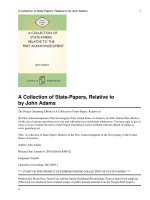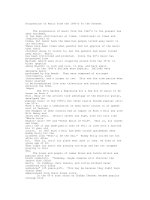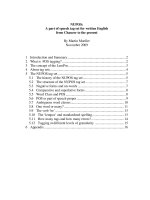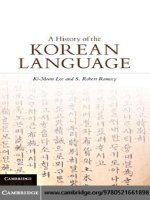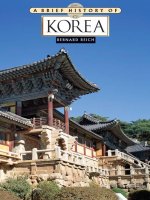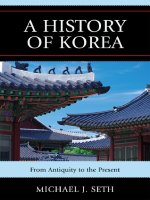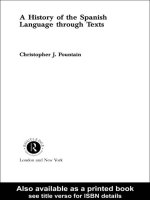a history of korea from antiquity to the present
Bạn đang xem bản rút gọn của tài liệu. Xem và tải ngay bản đầy đủ của tài liệu tại đây (2.89 MB, 595 trang )
A History of Korea
10_450_01_Front.indd i10_450_01_Front.indd i 9/21/10 5:22 AM9/21/10 5:22 AM
10_450_01_Front.indd ii10_450_01_Front.indd ii 9/21/10 5:22 AM9/21/10 5:22 AM
ROWMAN & LITTLEFIELD PUBLISHERS, INC.
Lanham
•
Boulder
•
New York
•
Toronto
•
Plymouth, UK
A History of Korea
From Antiquity to the Present
Michael J. Seth
10_450_01_Front.indd iii10_450_01_Front.indd iii 9/21/10 5:22 AM9/21/10 5:22 AM
Published by Rowman & Littlefield Publishers, Inc.
A wholly owned subsidiary of The Rowman & Littlefield Publishing Group, Inc.
4501 Forbes Boulevard, Suite 200, Lanham, Maryland 20706
Estover Road, Plymouth PL6 7PY, United Kingdom
Copyright © 2011 by Rowman & Littlefield Publishers, Inc.
All rights reserved. No part of this book may be reproduced in any form or by
any electronic or mechanical means, including information storage and retrieval
systems, without written permission from the publisher, except by a reviewer
who may quote passages in a review.
British Library Cataloguing in Publication Information Available
Library of Congress Cataloging-in-Publication Data
Seth, Michael J., 1948–
A history of Korea : from antiquity to the present / Michael J. Seth.
p. cm.
Includes bibliographical references and index.
ISBN 978-0-7425-6715-3 (cloth : alk. paper) — ISBN 978-0-7425-6716-0 (pbk. :
alk. paper) — ISBN 978-0-7425-6717-7 (electronic)
1. Korea—History. 2. Korea—Civilization. I. Title.
DS907.18.S426 2011
951.9—dc22
2010032330
ϱ
™
The paper used in this publication meets the minimum requirements of
American National Standard for Information Sciences—Permanence of Paper
for Printed Library Materials, ANSI/NISO Z39.48-1992.
Printed in the United States of America
10_450_01_Front.indd iv10_450_01_Front.indd iv 9/21/10 5:22 AM9/21/10 5:22 AM
v
List of Primary Source Readings xi
Maps xiii
Introduction 1
1 The Origins 9
The Koreans 9
Early Inhabitants 10
The Age of Rice Farming Begins 13
Sources for Early Korea 16
Chosoˇn 16
The Chinese Commanderies 18
Chinese Commanderies and Their Neighbors: The Northern
Peoples 20
Chinese Commanderies and Their Neighbors: The Southern
Peoples 22
Politics of the Third Century 23
Korea in Global Perspective: 5,000 Years of History 24
2 The Period of the Three Kingdoms, 4th Century to 676 27
The Emergence of the Three Kingdoms 28
The Wa and the Mimana 31
Korea and Northeast Asia in the Fourth and Fifth Centuries 32
Culture and Society of the Three Kingdoms 34
The Bone-Ranks, the Hwabaek, and the Hwarang 39
Contents
10_450_01_Front.indd v10_450_01_Front.indd v 9/21/10 5:22 AM9/21/10 5:22 AM
vi Contents
The Changing Environment of the Late Sixth and
Seventh Centuries 42
The Unification of Korea under Silla 44
Korea in Global Perspective: State Formation 46
3 Late Silla, 676 to 935 49
The Peninsular Kingdom 49
Consolidation of Central Monarchical Rule under Silla,
676–780 50
Silla and the Chinese Model 52
Supporting the Silla State 53
Silla Society 57
Silla and Its Neighbors 64
Parhae 67
The Decline of Silla 69
The Later Three Kingdoms 70
Korea in Global Perspective: Silla’s Rise and Fall 73
4 Koryoˇ, 935 to 1170 77
The New Koryoˇ State 77
Koryoˇ in East Asia 85
Internal Politics, 935–1170 88
Koryoˇ Culture 90
The Samguk Sagi 93
Koryoˇ Society 95
Korea in Global Perspective: Koryoˇ’s Examination System 98
5 Military Rulers and Mongol Invaders, 1170 to 1392 103
Military Rule 103
Soˇn Buddhism 107
Korea, Japan, and Feudal Europe 108
The Mongol Invasions 110
The Legacy of the Mongol Period 113
Late Koryoˇ Society 115
The End of the Koryoˇ 116
Late Koryoˇ Culture 118
The Rise of Neo-Confucianism 120
Korea in Global Perspective: The Mongols and Korea 123
6 The Neo-Confucian Revolution and the Chosoˇn State, 1392
to the 18th Century 127
Establishing the Yi Dynasty 127
The Chosoˇn State 131
The Censorate and the Classics Mat 133
Historians 134
10_450_01_Front.indd vi10_450_01_Front.indd vi 9/21/10 5:22 AM9/21/10 5:22 AM
Contents vii
The Examination System 135
Education 139
Agricultural Improvements and the State 141
Military and Foreign Affairs 142
The Japanese and Manchu Invasions 146
Competition for Power among the Elite 150
Chosoˇn Politics in Perspective 154
Korea in Global Perspective: Chosoˇn as an Ideologically
Driven State 154
7 Chosoˇn Society 157
The Family 158
Women during the Yi Dynasty 161
Social Structure 165
Slaves and Outcastes 167
Crime and Punishment 172
Religious Beliefs and Practices 174
Philosophy 176
Arts, Literature, and Science 179
Technology and Inventions 184
Korea in Global Perspective: Women in Korea 184
Korea in Global Perspective: Chosoˇn’s Social Hierarchy 186
8 Late Chosoˇn, Early 18th Century to 1876 189
The Politics of Late Chosoˇn 190
Late Chosoˇn and the Confucian World Order 191
Korean Travelers to China and Japan 194
Taxation and Reform 197
Agriculture 200
Commerce and Trade 201
Cultural Flowering of Late Chosoˇn 204
Sirhak 210
Everyday Life 212
Korea in the Nineteenth Century: The “Hermit Kingdom” 215
Internal Problems in the Nineteenth Century 216
Korea in Global Perspective: The Hermit Kingdom? 221
9 Korea in the Age of Imperialism, 1876 to 1910 225
Early Contacts with the West 225
The Opening of Korea 230
Early Reforms, 1876–1884 234
The Chinese Decade, 1885–1894 240
The Tonghak Rebellion 243
Kabo Reforms 246
10_450_01_Front.indd vii10_450_01_Front.indd vii 9/21/10 5:22 AM9/21/10 5:22 AM
viii Contents
The Russian Ascendency and the Independence Club 249
The Russo-Japanese War and the Protectorate 252
The Protectorate, 1905–1910 254
Korea in Transition 257
Korea in Global Perspective: Korea in the Age
of Imperialism 259
10 Colonial Korea, 1910 to 1945 265
The March First Movement 267
The Post–March First Period 269
Cultural Ferment of the 1920s 271
Moderate and Radical Nationalism 272
Economic Development 280
Modernity and Social Change 282
Rural Society 289
Wartime Colonialism, 1931–1945 292
Forced Assimilation 296
A Society in Turmoil: The Legacy of Colonial Rule 297
Korea in Global Perspective: The Korean
Nationalist Movement 299
Korea in Global Perspective: Korea’s Colonial Experience 300
11 Division and War, 1945 to 1953 305
The End of Colonial Rule in Korea 308
North Korea under Soviet Occupation 309
South Korea under U.S. Occupation 311
Trusteeship 312
Establishing a Separate Regime in the North 313
The Beginnings of a New Regime in the South 314
Toward Division 316
The Republic of Korea 317
The Democratic People’s Republic of Korea 320
On the Eve of the Korean War 321
The Korean War 324
The Impact of the Korean War 332
Korea in Global Perspective: Divided Countries 333
Korea in Global Perspective: The Korean War 334
12 North Korea: Recovery, Transformation, and Decline,
1953 to 1993 339
The Divergent Paths of the Two Koreas 339
North Korea’s Recovery 340
Political Consolidation 344
The Changing International Situation 347
10_450_01_Front.indd viii10_450_01_Front.indd viii 9/21/10 5:22 AM9/21/10 5:22 AM
Contents ix
Confrontational Stance toward the South and the
United States 350
Relentless Militarization 353
The Ideology of Self-Reliance 355
The Cult of the Kim Family 358
Society 362
Economic Problems 365
Korea in Global Perspective: North Korea as a
Communist Country 368
13 South Korea: From Poverty to Prosperity, 1953 to 1997 373
The Syngman Rhee Years, 1953–1960 373
The Democratic Experiment, 1960–1961 376
The Military Coup 378
Economic Transformation 381
Economic Growth under Park Chung Hee 383
Chaeboˇls 389
Transformation of the Countryside 392
Economic Development in the 1980s 394
Explaining South Korea’s Economic Miracle 395
Education 398
Korea in Global Perspective: Educational Development 400
Korea in Global Perspective: Economic Development 401
14 South Korea: Creating a Democratic Society, 1953 to 1997 405
Military Authoritarianism 405
The Yushin Era, 1971–1979 407
Seoul Spring, 1979–1980 411
The Fifth Republic 414
1987: A Political Turning Point 415
Transition to Democracy 418
Understanding the Democratic Turn 422
Student Activism 426
Organized Labor 428
Social and Cultural Transition 431
Korea in Global Perspective: Democratization 434
15 Contemporary North Korea, 1993 to 2010 437
In Decline 437
A Period of Crisis 439
Under Kim Jong Il 441
Ideology 442
Famine 444
Crisis and Summitry 446
10_450_01_Front.indd ix10_450_01_Front.indd ix 9/21/10 5:22 AM9/21/10 5:22 AM
x Contents
Tentative Reforms 448
Confrontations and the Policy of Survival 451
Korea in Global Perspective: North Korea’s Famine 457
Korea in Global Perspective: North Korea as a Failed State 458
16 Contemporary South Korea, 1997 to 2010 465
Return to Civilian Government 465
Economic Crisis and Recovery 469
Domestic Politics 471
Foreign Policy 477
Rethinking Reunification 480
A Society Undergoing Rapid Change 481
Changing Gender Relations, Changing Families 485
Ethnic Homogeneity 487
Facing History and Preserving Heritage 489
New Crises and New Problems 491
Korea in Global Perspective: South Korea’s Place in
the World 492
Conclusion 497
Appendix: Romanization 503
Notes 507
Glossary of Korean Words 529
Annotated Selected Bibliography 539
Index 555
About the Author 573
10_450_01_Front.indd x10_450_01_Front.indd x 9/21/10 5:22 AM9/21/10 5:22 AM
xi
The Tan’gun Myth 25
Origins of the Hwarang 47
King Huˇngdoˇk’s Edict on Clothing, Carts, and Housing 47
Soˇl Kye-du 74
Great Master Kyunyoˇ: Eleven Poems on the Ten Vows of
the Universally Worthy Bodhisattva 74
Wang Koˇn: Ten Injunctions 99
Manjoˇk’s Slave Rebellion 124
Yun Hoe: On the Harmfulness of Buddhism 156
Sin Ch’oˇjung: On the Deceitfulness of Buddhism 156
The Creation of the Han’guˇl Script 187
Regulating Marriage 223
Inaugural Message of the Independent, April 7, 1896 261
Chang Chiyoˇn, “We Wail Today” 262
Son Pyoˇnghuˇi et al., Declaration of Independence 302
Summary of the Instructions of Commanding General
Chistiakov at the Meeting of the Five Provinces 336
Kim Il Sung, from “Report on the Work of the Central Committee
to the Fourth Congress of the Workers Party of Korea” 370
Kim Il Sung, from “Socialist Construction in the Democratic
People’s Republic of Korea and the South Korean Revolution” 371
Park Chung Hee, from The Country, the Revolution and I 402
Kim Chi-ha: Five Thieves 435
“Publishing Comrade Kim Jong Il’s Brief History” 460
An Account of the Famine 461
Kim Dae Jung, from Prison Writings 494
Primary Source Readings
10_450_01_Front.indd xi10_450_01_Front.indd xi 9/21/10 5:22 AM9/21/10 5:22 AM
10_450_01_Front.indd xii10_450_01_Front.indd xii 9/21/10 5:22 AM9/21/10 5:22 AM
Physical Map of Korea
10_450_01_Front.indd xiii10_450_01_Front.indd xiii 9/21/10 5:22 AM9/21/10 5:22 AM
Physical Map of East Asia
10_450_01_Front.indd xiv10_450_01_Front.indd xiv 9/21/10 5:22 AM9/21/10 5:22 AM
Korea in the Fifth Century
10_450_01_Front.indd xv10_450_01_Front.indd xv 9/21/10 5:22 AM9/21/10 5:22 AM
Silla and Parhae Kingdoms
10_450_01_Front.indd xvi10_450_01_Front.indd xvi 9/21/10 5:22 AM9/21/10 5:22 AM
Koryoˇ in the Eleventh Century
10_450_01_Front.indd xvii10_450_01_Front.indd xvii 9/21/10 5:22 AM9/21/10 5:22 AM
Chosoˇn Korea
10_450_01_Front.indd xviii10_450_01_Front.indd xviii 9/21/10 5:22 AM9/21/10 5:22 AM
Modern Korea
10_450_01_Front.indd xix10_450_01_Front.indd xix 9/21/10 5:22 AM9/21/10 5:22 AM
10_450_01_Front.indd xx10_450_01_Front.indd xx 9/21/10 5:22 AM9/21/10 5:22 AM
1
K
orea is an ancient land with 2,000 years of recorded history and a
rich and distinctive cultural tradition. The various peoples that lived
in the peninsula gradually forged a society characterized by cultural
homogeneity and political unity. Korea today is divided into two rival
states, but this is a fairly recent development. Before being effectively
partitioned by the United States and the Soviet Union in 1945, Korea had
been one of the oldest continuously unified states in the world. The pen-
insular heartland of what is today Korea was united in 676, and except for
one brief period, remained so until the end of World War II. It had also
become one of the most homogeneous societies in the world. A number of
peoples entered the peninsula in antiquity, but gradually all merged into
a single ethnicity, sharing one language and participating in one political
system. In modern times there have been no significant ethnic minorities.
Binding Koreans together and distinguishing them from their neigh-
bors has been their language. Korean, while showing some similarities to
Japanese and to the Altaic languages of Inner Asia, is also quite distinct
from them. In modern times all Koreans spoke the Korean language,
which since the fifteenth century has been written in a unique alphabet.
Before the twentieth century, there were no significant Korean-speaking
groups outside of Korea. Thus, Korea became one of the few lands where
ethnicity, membership in a language community, and a state were coter-
minous. This unity and homogeneity that emerged over the centuries has
become an important part of Korean identity.
In the late nineteenth century few if any states could match Korea’s ter-
ritorial and institutional stability, its historical continuity, its ethnic unity
Introduction
10_450_02_Introduction.indd 110_450_02_Introduction.indd 1 9/21/10 5:23 AM9/21/10 5:23 AM
2 Introduction
and its isolation. The last earned it the sobriquet “the hermit kingdom.”
As with so much of the non-Western world Korea became a victim of the
age of imperialism. Its colonial experience was atypical, however, in that
it was ruled by Japan, another non-Western society, a familiar neighbor
with which it shared many cultural affinities. But what makes Korea’s
modern history unique was its division in 1945 by the United States and
the Soviet Union at the thirty-eighth parallel. Korea was divided along
a totally arbitrary line that had no historical, geographical, cultural, or
economic logic; just a line that conveniently separated the country into
roughly two halves—dividing provinces, valleys, and families. A nation
that was arguably the most ethnically homogeneous in the world, with
thirteen centuries of political unity, with national and provincial bound-
aries older than almost any other state, was cut into halves by the two
superpowers.
While in theory this was only a temporary measure, almost imme-
diately two separate regimes emerged. In 1948, the United States and
the Soviet Union set up their client states: the Republic of Korea, better
known as South Korea, and the Democratic People’s Republic of Korea, or
North Korea. The two “Koreas” had different leaders, different political
and economic systems, and different external orientations. Both saw the
division as an unacceptable and temporary condition, but the attempts
to unify the country led to one of the bloodiest conflicts since the end of
World War II. Despite horrific destruction and loss of life, both regimes
survived and continued on their markedly different trajectories of devel-
opment. North Korea evolved into one of the world’s most totalitarian
and militant states, ruled by a family with a cult of personality unequaled
in its extreme intensity. It was the world’s most closed and enigmatic
state, with a leadership busy developing missiles and nuclear weapons
while millions of the nation’s children were stunted from malnutrition.
South Korea, by contrast, after a rocky and uncertain start evolved into
an open, democratic society, whose spectacular economic growth and in-
ternationally competitive industries made it an outstanding success story
among the postcolonial states.
Nowhere else was a nation so arbitrarily divided and the peoples of the
two halves so effectively isolated from each other; nowhere else did such
radically different political and social systems emerge. The boundary
between the two Koreas is not only the world’s most heavily armed and
until recently most hermetically sealed, it marks two different living stan-
dards and lifestyles. Nowhere else is there such a sharp contrast between
two contiguous states—one rich, democratic, and cosmopolitan; the other
impoverished, totalitarian, and isolated. And arguably the history of no
other society in the past century offers such contrasting examples of how
societies can undergo modern development. Korea’s modern history is
10_450_02_Introduction.indd 210_450_02_Introduction.indd 2 9/21/10 5:23 AM9/21/10 5:23 AM
Introduction 3
both a remarkable story and an incomparable example of how the inter-
play of historical contingency, policy choices, and cultural heritage can
shape societies in contrasting ways.
Korea is also a fascinating land with a rich and distinctive culture that
continues to evolve in interesting and even surprising ways. Yet Korea
and its history have often been overlooked in the past. Except for the
Korean War it has not, at least until recently, drawn much attention from
the rest of the world. Partly this is due to the fact that it has been over-
shadowed by it larger neighbors, China and Japan.
Today Korea is emerging from its past obscurity. On the negative side
there is the notoriety of Kim Jong Il and the North Korean nuclear threat.
But South Korea has become a major world economy whose corporate
names LG, Samsung, and Hyundai are globally recognized and whose
popular culture has a huge audience among its Asian neighbors and is
beginning to be known beyond Asia. Yet its remarkable history, with its
important implications, is still not widely known or appreciated.
Geographically, Korea is a mountainous peninsula about 600 miles
long and an average of 120 miles wide with a mixture of maritime and
continental climates. The mountains are not high, reaching only 9,000 feet
with Mount Paektu on the border between North Korea and Manchuria.
Yet no place in Korea is not within sight of them.
Arable land is limited but well watered and fertile. Winters vary from
short and mild in the south to long and bitter cold in the north; summers
are wet and humid almost everywhere. The wet, humid summer and dry
autumn are ideal for growing rice, and except in the far north where it
is too cold to cultivate, rice has been the staple crop for several millen-
nia. Wet rice agriculture is labor intensive but produces high yields per
acre. Therefore, despite the limited amount of land suitable for farming,
Korea has been for centuries a densely populated country and until quite
recently an overwhelmingly rural, agricultural one.
No part of Korea is far from the seas. The seas, however, while filled
with abundant fish and seafood, important components in the Korean
diet, are not friendly to navigation. The east coast on the Sea of Japan (or
“East Sea” as the Koreans call it) has few good harbors and is cut off from
the major population centers by rugged mountains. Navigation on the
western Yellow Sea coast is made difficult by shifting sandbars and some
of the world’s highest tides. Confined to a geographically well-defined
peninsula with ample resources to support a fairly populous agricultural
society Korea developed its own distinctive society and identity while
borrowing heavily from China.
Korea is a modest-sized country surrounded by much larger neighbors:
China, Japan, and Russia. The fact that it has been lodged between the im-
portant and culturally rich Chinese and Japanese societies helps account
10_450_02_Introduction.indd 310_450_02_Introduction.indd 3 9/21/10 5:23 AM9/21/10 5:23 AM
4 Introduction
for the lack of attention its history has attracted. It has been difficult for
Koreans to emerge from the shadow of their East Asian neighbors and to
make their presence and their culture known to the rest of the world. Yet
Korea, small as it seems next to its neighbors, is not all that small. The
area of North and South Korea combined is 84,000 square miles, about the
same as Utah. This sounds unimpressive, but it is also the same size as
the United Kingdom and a little smaller than another peninsular society,
Italy, which it roughly resembles in shape. In population today North
Korea has about 23 million inhabitants and South Korea 47 million for a
total of 70 million, a little larger than that of Britain, France, or Italy, and
a little smaller than that of Germany.
Korea has been a part of an East Asian civilization centered in China.
China was one of the earliest homes of agriculture, urbanization, state
structures, and literacy. As long as three and a half millennia ago a culture
emerged in northern China that was recognizably Chinese. This culture
profoundly influenced its neighbors, Korea, Vietnam, and Japan, to the
extent that the cultures of these societies can be viewed as offshoots of
Chinese civilization. Literate states emerged first in Korea and then Japan
in the early centuries of the first millennium CE. From China the Koreans
received their writing system. Although in the fifteenth century the Ko-
reans invented their own unique alphabet, Chinese characters were the
main means of writing until the twentieth century. The Korean language
borrowed much of its higher vocabulary from Chinese, much as English
borrowed most of its educated vocabulary from Latin and Greek. Kore-
ans then brought literacy farther eastward to their Japanese neighbors.
Written classical Chinese was studied by all educated Koreans before the
twentieth century, and it served as the means for communicating with
their Chinese, Japanese, and Vietnamese neighbors.
China provided the model for literature, art, music, architecture, dress,
and etiquette. From China Koreans imported most of their ideas about
government and politics. They accepted the Chinese worldview in which
China was the center of the universe and the home of all civilization, and
its emperor the mediator between heaven and earth. Koreans took pride
in their adherence to Chinese cultural norms. For most of the period from
the seventh to the nineteenth century they accepted their country’s role
as a subordinate member of the international hierarchy in which China
stood at the apex, loyal adherents of Chinese culture such as Korea ranked
next, and the barbarians outside Chinese civilization stood at the bottom.
Close adherence to civilized standards was a source of pride. But this
did not result in a loss of separate identity. On the contrary, in adapting
Chinese culture to their own society Koreans defined their own cultural
distinctiveness. Nor did Korea’s membership in the “tributary system” in
which the Korean king became a vassal of the Chinese emperor mean that
10_450_02_Introduction.indd 410_450_02_Introduction.indd 4 9/21/10 5:23 AM9/21/10 5:23 AM

